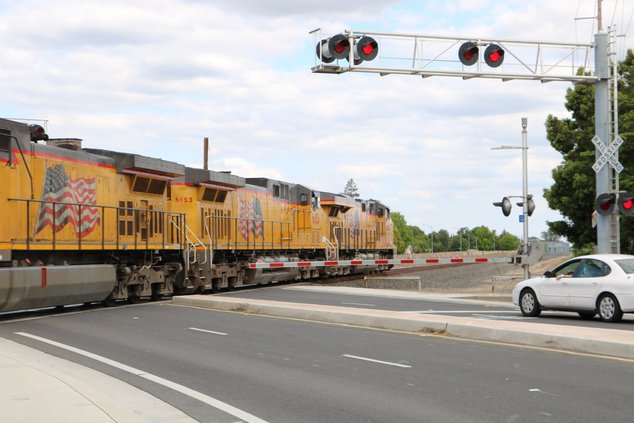It took just one section of broken rail.
A few minutes later, 49 cars of an 82-car train hauling explosives, hazardous chemicals and other freight through downtown Manteca had derailed.
The worst part of the mess occurred in the track section between the 120 Bypass overcrossing and Manteca High.
Initially, first responders had a hard time seeing the extent of the derailment given dense tule fog.
That incident in 1989 led to the evacuation of 200 people living in the Powers Tract neighborhood and took two days to clean up.
There were no injuries and no property damage except for the train and its contents.
In 2021, there were 1,106 train derailments in the United States or 3.18 per day. That is significantly lower than the 6,442 or 17.6 per day that occurred in 1980.
Most are minor affairs involving several cars. Occasionally there are major derailments.
And then there are those that result in dangerous spills and fires such as the 38 cars of the Norfolk Southern freight train that derailed in Ohio during February as well as the Minnesota train derailment last week where tankers carrying ethanol caught on fire.
Potential derailments are just one of three high-profile disasters that the Manteca Fire Department trains for when they aren’t answering emergency call or being involved in fire safety inspections and other fire prevention measures.
Manteca Fire Chief Dave Marques said the emphasis on training for disasters is simple.
“We want our response to be second nature,” Marques said.
The fire department in 2022 spent more than 15,245 hours training.
Besides structure fires, extractions for vehicles, grass fires, and handling chemical spills that could occur at local concerns the department also prepares for three disaster scenarios — floods, train derailments, and earthquakes.
The frequency of flood threats puts that disaster scenario at the top of the list.
A portion of Manteca is in the 100-year floodplain and the most problematic section of the San Josquin River levee system protects Manteca and Lathrop.
Not only is Manteca in close proximity to major Bay Area quake faults, but there are four near Manteca that are considered active.
*The Vernalis fault that starts near Dairy Road south of Highway 132 in Stanislaus County then runs north eventually paralleling Kasson Road, passing by the shuttered Deuel Vocational Institute and Banta before ending near the Old River northeast of Tracy.
*The Tracy-Stockton fault that runs under Stockton. It had significant shaking in 1881 and 1940. The epicenter of both was in Linden. The 1940 event was 4.0 on the Richter scale. By comparison the 1989 Loma Prieta quake registered at 6.9 on the Richter scale.
*The San Joaquin Fault that runs along the base of the Coastal Ranges from east of Newman to east of Tracy.
*The Corral Hollow fault southwest of Tracy a scientist discovered in 1991.
The Vernalis Fault at one point near the Airport Way bridge is within several hundred yards of the San Joaquín River south of Manteca.
The potential for train derailments are never off of the department’s radar.
That’s because the city is split in half by not just the Union Pacific’s main north-south corridor in California — the Fresno line — but the city’s western border is UP’s line that heads over the Altamont Hills into the Bay Area.
Between the two lines, there are upwards of 56 trains a day.
Eventually, UP anticipates train movements to reach 135 trains a day.
The most problematic of the two lines is the Fresno line that slices through the city.
“We have homes that back up to the railroad tracks all the way through town,” Marques noted.
The last major train derailment in Manteca was in July 2019. A 114-car Union Pacific freight train came off the tracks, starting a fire and blocked vehicle access from Austin to Moffat Boulevard. Fourteen cars were derailed.
The most notorious train mishap in Northern California was April 28, 1973 Roseville rail yard disaster when a train carrying munitions for the Vietnam War exploded.
A small fire caused by overheated brakes triggering the first munitions explosion. By the time 32 hours had passed, 18 boxcars had exploded destroying buildings, rail sections and creating huge craters in the ground. That incident occurred on the then Southern Pacific lines that are now a part of the Union Pacific system.
Marques noted the Manteca Fire Department routinely trains with other agencies they would be part of a mutual response to a major disaster.
Manteca also has a solid working relationship with Union Pacific.
To contact Dennis Wyatt, email dwyatt@mantecabulletin.com






